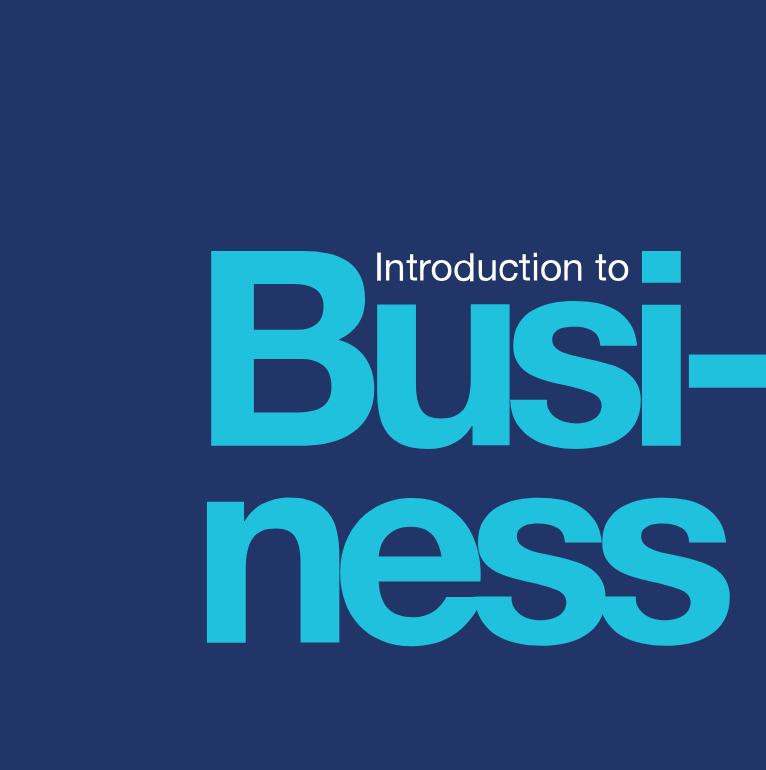Introduction to Business Course Outline
How do the world’s economies and governments shape economic activity?
Concepts Covered:
- How do businesses and not-for-profit organizations help create our standard of living?
- What are the sectors of the business environment, and how do changes in them influence business decisions?
- What are the primary features of the world’s economic systems, and how are the three sectors of the U.S. economy linked?
- How do economic growth, full employment, price stability, and inflation indicate a nation’s economic health?
- How does the government use monetary policy and fiscal policy to achieve its macroeconomic goals?
- What are the basic microeconomic concepts of demand and supply, and how do they establish prices?
- What are the four types of market structure?
- Which trends are reshaping the business, microeconomic, and macroeconomic environments and competitive arena?
How are individual business ethics are formed?
Concepts Covered:
- What philosophies and concepts shape personal ethical standards?
- How can organizations encourage ethical business behavior?
- What is corporate social responsibility?
- How do businesses meet their social responsibilities to various stakeholders?
- What are the trends in ethics and corporate social responsibility?
What are the processes of taking a business global?
Concepts Covered:
- Why is global trade important to the United States, and how is it measured?
- Why do nations trade?
- What are the barriers to international trade?
- How do governments and institutions foster world trade?
- What are international economic communities?
- How do companies enter the global marketplace?
- What threats and opportunities exist in the global marketplace?
- What are the advantages of multinational corporations?
- What are the trends in the global marketplace?
What are the common forms of business ownership?
Concepts Covered:
- What are the advantages and disadvantages of the sole proprietorship form of business organization?
- What are the advantages of operating as a partnership, and what downside risks should partners consider?
- How does the corporate structure provide advantages and disadvantages to a company, and what are the major types of corporations?
- What other options for business organization does a company have in addition to sole proprietorships, partnerships, and corporations?
- What makes franchising an appropriate form of organization for some types of business, and why does it continue to grow in importance?
- Why are mergers and acquisitions important to a company’s overall growth?
- What current trends will affect the business organizations of the future?
Just how important are small businesses to our economy?
Concepts Covered:
- Why do people become entrepreneurs, and what are the different types of entrepreneurs?
- What characteristics do successful entrepreneurs share?
- How do small businesses contribute to the U.S. economy?
- What are the first steps to take if you are starting your own business?
- Why does managing a small business present special challenges for the owner?
- What are the advantages and disadvantages facing owners of small businesses?
- How does the Small Business Administration help small businesses?
- What trends are shaping entrepreneurship and small-business ownership?
How do leadership styles influence a corporate culture?
Concepts Covered:
- What is the role of management?
- What are the four types of planning?
- What are the primary functions of managers in organizing activities?
- How do leadership styles influence a corporate culture?
- How do organizations control activities?
- What roles do managers take on in different organizational settings?
- What set of managerial skills is necessary for managerial success?
- What trends will affect management in the future?
What needs to be considered when designing organizational structures?
Concepts Covered:
- What are the traditional forms of organizational structure?
- What contemporary organizational structures are companies using?
- Why are companies using team-based organizational structures?
- What tools do companies use to establish relationships within their organizations?
- How can the degree of centralization/decentralization be altered to make an organization more successful?
- How do mechanistic and organic organizations differ?
- How does the informal organization affect the performance of the company?
- What trends are influencing the way businesses organize?
What are the elements of the human resource management process?
Concepts Covered:
- What is the human resource management process, and how are human resource needs determined?
- How do firms recruit applicants?
- How do firms select qualified applicants?
- What types of training and development do organizations offer their employees?
- How are performance appraisals used to evaluate employee performance?
- What are the types of compensation and methods for paying workers?
- What is a labor union and how is it organized, what is collective bargaining, and what are some of the key negotiation issues?
- How are grievances between management and labor resolved, and what tactics are used to force a contract settlement?
- What are the key laws and federal agencies affecting human resource management and labor relations?
- What trends and issues are affecting human resource management and labor relations?
What is the key to Motivating Employees?
Concepts Covered:
- What are the basic principles of Frederick Taylor’s concept of scientific management?
- What did Elton Mayo’s Hawthorne studies reveal about worker motivation?
- What is Maslow’s hierarchy of needs, and how do these needs relate to employee motivation?
- How are McGregor’s Theories X and Y and Ouchi’s Theory Z used to explain worker motivation?
- What are the basic components of Herzberg’s motivator-hygiene theory?
- What four contemporary theories on employee motivation offer insights into improving employee performance?
- How can managers redesign existing jobs to increase employee motivation and performance?
- What initiatives are organizations using today to motivate and retain employees?
How do manufacturers and service firms manage and control the creation of products and services?
Concepts Covered:
- Why is production and operations management important in both manufacturing and service firms?
- The Production Process: How Do We Make It?
- Location, Location, Location: Where Do We Make It?
- Why are resource-planning tasks such as inventory management and supplier relations critical to production?
- How do operations managers schedule and control production?
- How can quality-management and lean-manufacturing techniques help firms improve production and operations management?
- What roles do technology and automation play in manufacturing and service-industry operations management?
- What key trends are affecting the way companies manage production and operations?
How is the marketing mix is used to create sales opportunities?
Concepts Covered:
- What is the marketing concept and relationship-building?
- How do managers create a marketing strategy?
- What is the marketing mix?
- How do consumers and organizations make buying decisions?
- What are the five basic forms of consumer and business market segmentation?
- What Is a Product?
- How do organizations create new products?
- What are the stages of the product life cycle?
- What strategies are used for pricing products, and what are the future trends?
- What trends are occurring in products and pricing?
What are the major roles of marketing?
Concepts Covered:
- What is the nature and function of distribution (place)?
- What is wholesaling, and what are the types of wholesalers?
- What are the different kinds of retail operations?
- How can supply-chain management increase efficiency and customer satisfaction?
- What is promotion, and what are the key elements of a promotional mix?
- How are advertising media selected?
- What is personal selling?
- What are the goals of sales promotion, and what are several types of sales promotion?
- How does public relations fit into the promotional mix?
- What is social media, and how has it changed promotion?
- What is e-commerce, and how has it affected the retail sector?
That is the role of information technology in business?
Concepts Covered:
- How has information technology transformed business and managerial decision-making?
- Why are computer networks an important part of today’s information technology systems?
- What types of systems make up a typical company’s management information system?
- How can technology management and planning help companies optimize their information technology systems?
- What are the best ways to protect computers and the information they contain?
- What are the leading trends in information technology?
How does accounting contribute to a company’s overall success?
Concepts Covered:
- Why are financial reports and accounting information important, and who uses them?
- What are the differences between public and private accountants, and how has federal legislation affected their work?
- What are the six steps in the accounting cycle?
- In what terms does the balance sheet describe the financial condition of an organization?
- How does the income statement report a firm’s profitability?
- Why is the statement of cash flows an important source of information?
- How can ratio analysis be used to identify a firm’s financial strengths and weaknesses?
- What major trends affect the accounting industry today?
What is the role of financial institutions in U.S. and international economies?
Concepts Covered:
- What is money, what are its characteristics and functions, and what are the three parts of the U.S. money supply?
- How does the Federal Reserve manage the money supply?
- What are the key financial institutions, and what role do they play in the process of financial intermediation?
- How does the Federal Deposit Insurance Corporation (FDIC) protect depositors’ funds?
- What roles do U.S. banks play in the international marketplace?
- What trends are reshaping financial institutions?
What key trends affect financial management and securities markets?
Concepts Covered:
- How do finance and the financial manager affect the firm’s overall strategy?
- What types of short-term and long-term expenditures does a firm make?
- What are the main sources and costs of unsecured and secured short-term financing?
- What are the key differences between debt and equity, and what are the major types and features of long-term debt?
- When and how do firms issue equity, and what are the costs?
- How do securities markets help firms raise funding, and what securities trade in the capital markets?
- Where can investors buy and sell securities, and how are securities markets regulated?
- What are the current developments in financial management and the securities markets?
How can you kick off your Career in Business?
Concepts Covered:
- First: Learn the Basics of Business
- Developing Interpersonal Skills Is Key to Your Success
- Make Your Future Happen: Learn to Plan
- Going to College Is an Opportunity of a Lifetime—Never Drop Out
- Get Your Career Off on the Right Track
- Self-Test Scoring Guidelines









